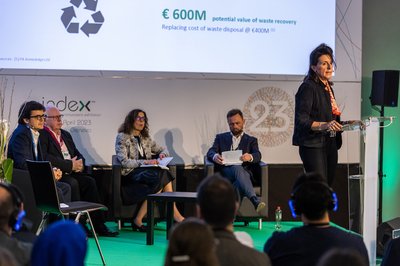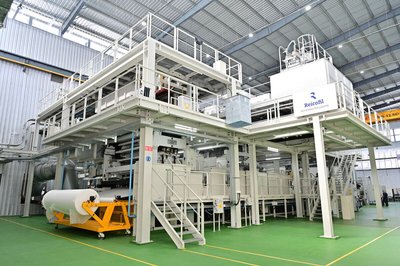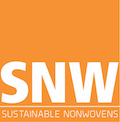
Increasing applications in the aerospace, automotive, consumer electronics and sporting goods industries are being found for nonwovens made from recycled carbon fibres.
As many efforts continue to develop effective processes for the 100% circular recovery of what is an extremely expensive fibre, its conversion in chopped strand form into nonwovens is currently one of the only commercially-viable options for providing a second life.
The demand for virgin carbon fibre materials as the reinforcement components of composite parts – which can be in woven, knitted or braided as well as nonwoven structures – continues to grow, and as much as 30% of all carbon composite production is wasted in manufacturing processes even before finished parts are produced.
With lightweight, strong and design-friendly carbon fibre composites now being key components in everything from aircraft and electric vehicles to hydrogen storage tanks and the next generation of super-sized turbine blades, global demand for the material is set to outstrip supply – from nearly 100,000 tons today to around 300,000 tons by 2030. This shortage will have an impact on many sectors striving to achieve net zero goals.
Dreamliner 787
In the aerospace industry, the use of carbon fibre as the basis for composite parts has grown from representing 10% of an aircraft body 30 years ago, to more than 50% on planes such as Boeing’s 777X and Dreamliner 787.
The Dreamliner contains approximately 23 tons of carbon fibre composite parts in its fuselage, wings, tail, doors and interior which help make it about 20% lighter than other comparably-sized aircraft.
Since 2018 Boeing has partnered with a UK-based specialist recycler which collects waste composites from Boeing sites and treats them in a furnace, vaporizing the resin holding the carbon fibre layers together to leave behind clean fibre material that is subsequently turned into new nonwovens.
These recycled carbon nonwovens have numerous applications, the most notable being as the basis for Dell laptop cases.
Dell, which makes some six million composite laptop cases annually, introduced recycled carbon into them in 2020.
Boeing is also exploring ways to introduce the recycled carbon into its own programmes and has tested the use of recycled carbon in parts such as sidewall panels and moisture-absorbing flooring.
Meanwhile, many initiatives are underway to more successfully keep high-cost carbon fibre in circulation beyond a second life in what are effectively downcycled products. Upcycling, or fully retaining the value of an input material, is the end-game.
EU ambition
The European Union’s ambitions for establishing a circular economy also extend far beyond expensive fibres such as carbon, to include both natural and synthetic commodity fibres and plastics of low value.
The separate collection of textile waste will become mandatory for all EU member states on 1st January 2025 and this – along with the EU’s Plastics Strategy introduced in 2020 – is already having a galvanising effect on efforts to increase recycling and reuse options.
This January, for example, Eastman announced a plan to invest up to $1 billion in a material-to-material molecular recycling facility for polyester in France by 2025. It will recycle up to 160,000 metric tons annually of hard-to-recycle polyester waste that is currently being incinerated.
Eastman’s polyester renewal technology is said to provide true circularity for hard-to-recycle waste which today is typically incinerated because it either cannot be mechanically recycled or must be downcycled with existing technology. The hard-to-recycle waste is broken down into its molecular building blocks and then reassembled to become first-quality material without any compromise in performance.
Eastman’s polyester renewal technology enables the potentially infinite value of materials by keeping them in production, lifecycle after lifecycle.
C-Zyme
Also in France, Indorama Ventures is partnering with Carbios to build an enzymatic PET bio-recycling production plant with a processing capacity of around 50,000 tons of post-consumer PET polyester waste per year by 2025.
Carbios has succeeded in producing both 100% enzymatically recycled white PET fibre and bottle-grade PET from mixed coloured textile waste, using its C-Zyme process.
France will also be the location for a new hybrid recycling plant in a joint venture between Dow and Valoregen aiming to recycle 70,000 tons of plastic waste per year.
It is one of two fibre and plastic recycling projects announced by Dow this year, the second involving a partnership with Mura, the developer of HydroPRS – hydrothermal plastic recycling solution – which can be used to recycle all forms of plastics which have previously been deemed unrecyclable. Once deployed at scale, it has the capability to prevent millions of tons of plastic and carbon dioxide from entering the environment every year.
The world’s first plant using Mura’s HydroPRS process, located in Teesside, UK, is expected to be operational in 2023 with an annual 20,000-tons per year production line, set to supply Dow with a 100% recycled feedstock. Dow and Mura’s planned global rollout is for as much as 600,000 tons of advanced recycling capacity by 2030.
ReHubs
The ambitious ReHubs initiative meanwhile, is calling for the establishment of between 150-250 dedicated new textile recycling hubs throughout Europe in the next few years, each with an annual capacity of between 50-100,000 tons.
ReHubs is being initiated by Euratex – the Brussels-based organisation which represents around 154,000 companies employing 1.47 million workers in the European textiles and clothing industries.
The aim is to achieve the successful fibre-to-fibre recycling of 2.5 million tons of Europe’s textile waste by 2030.
Europe has a 7 - 7.5-million-ton textile waste problem, of which only 30-35% is collected today, and very little of that is returned to fibre form to enable true value retention.
Once matured and scaled, Euratex believes this new industry could become profitable, with a total annual market size of between €6-8 billion, generating around 15,000 direct new jobs by 2030.
Scale is really the key to success in keeping materials in circulation – whether expensive carbon fibre or commodity synthetics – but it is clear that in Europe things are quickly moving in the right direction.









